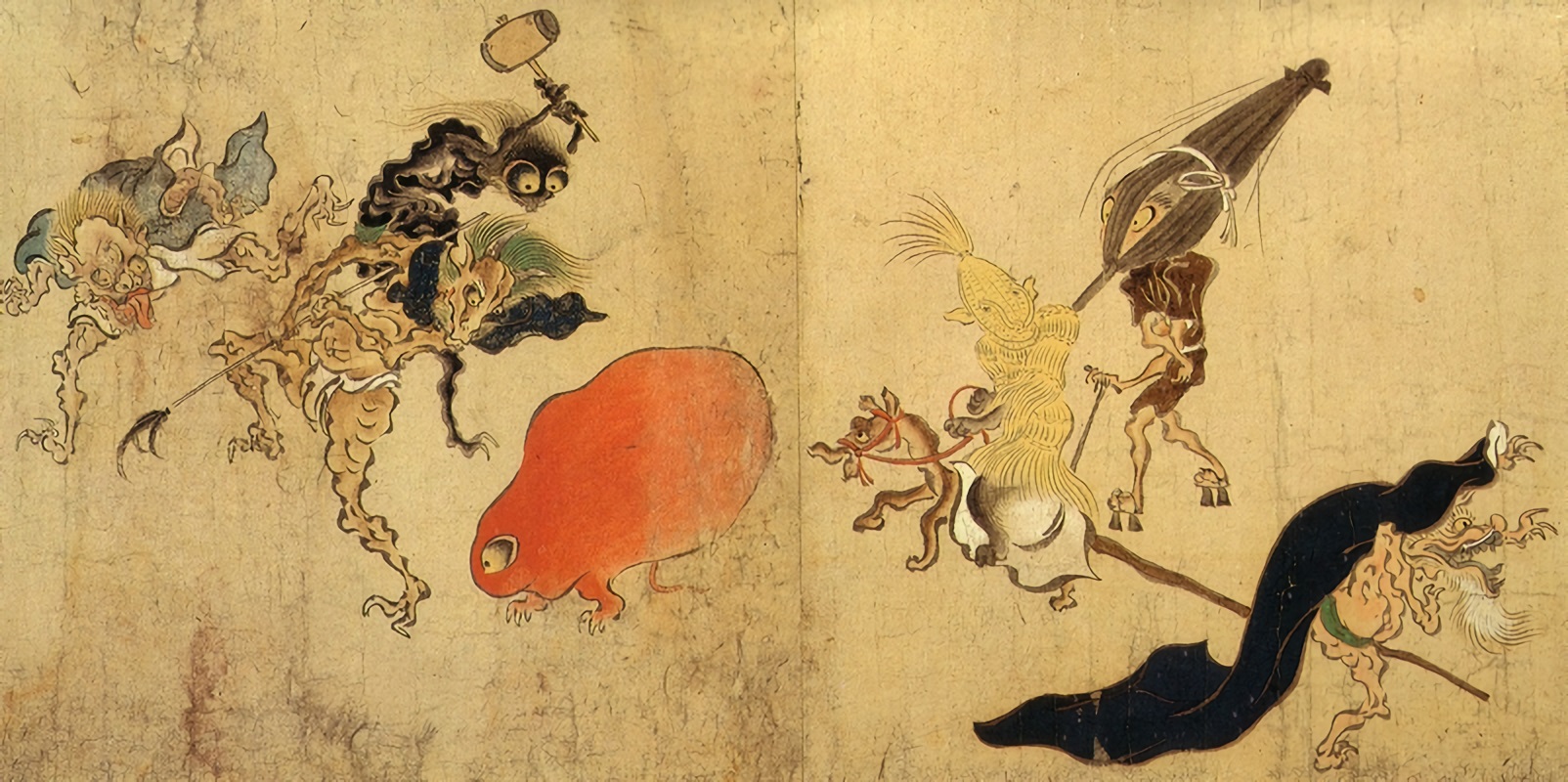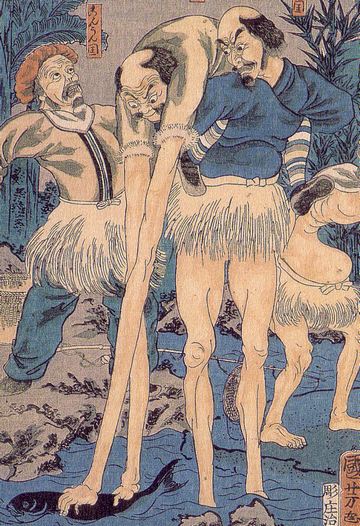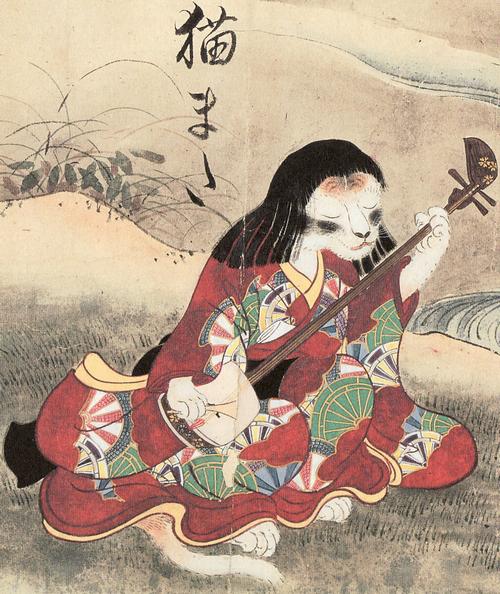
In Japanese folklore there exists a subset of supernatural beings known as the Yokai. Yokai is Japanese for ghost or phantom, though the Western connotations of these terms do not really do the creatures true nature justice. Yokai can be evil demons, hell bent on killing and damning their victims, or mischievous-personified household objects who want nothing more than to annoy, shock or scare you. Throughout Japanese history they have been used to explain strange occurrences and bad fortune, and are still present in the pop culture of modern Japan today, but more so as cartoon characters and manga villains. Below are ten strange examples of Japanese Yokai. Enjoy.
1. Ashinagatenaga

Ashinagatenaga is not a single Yokai, but two separate entities. The name is an amalgamation of the names Ashinaga and Tenaga. Ashinaga is a human looking Yokai with extremely long legs while Tenaga is a similar looking Yokai with extremely long arms. The lore says that each man comes from his own civilization full of people just like him. The stories claim that the two men, seeing their oddities as complementary, decided to join forces. Ashinaga clambered onto Tenaga’s shoulders and soon the two were wading into the waters off Kyushu and gathering fish too far out for men on the shore. This seems to imply that not only does Ashinaga have super long arms, but his reflexes must be pretty good as well. Despite being a fairly tame Yokai, some Japanese fishermen believed that if you spotted Ashinagatenaga fishing out in the shallows, bad weather was imminent. While this undoubtedly bad news for a fisherman, considering what the other Yokai on this list are up to, bad weather is getting off easy.
2. Nekomata

Cats may have made a resurgence in popularity in the age of the internet cat video, but cats have been historically popular in many cultures around the globe and Japan is no exception. Folklore claims that there are two types of Yokai that both go under the name of Nekomata. The first is straight forward monster, described as having feline eyes with the body of a dog and devouring anyone who wandered into it’s mountain territory. The more modern, and interesting, version is a bit stranger. In this bit of folklore, house cats that grow old will eventually leave home, grow a split tail (the mark of the Nekomata transformation), and go live in mountains. These mountain Nekomata vary in power but lore states that the worse a cat is treated during it’s ‘cat life’, the more powerful it will be as a Nekomata. This is not good for the negligent or abusive owner. They will be haunted by the Nekomata with visions of dead loved ones until the creature is satisfied. Apparently apparitions are just the tip of the iceberg; the Nekomata are also said to have the power to raise the dead and control them with commands from their paws and forked tail. The Nekomata was traditionally blamed for fires and other bad luck, and the stigma become so strong that some Japanese cat owners began removing their kittens tails just in case. I guess the other option was to be nice to your cat, but what do I know.
3. Biwa-bokuboku

The Biwa-bokuboku is our first Tsukumogami, or artifact ghost. These Yokai are like creepy versions of the singing household objects in Beauty and the Beast. This particular Yokai has the head of a biwa, a traditional East Asian string instrument, and the body of a Shinto or Buddhist monk. When the Biwa-bokuboku appears, he is either going to sit quietly in your house, weeping about his loneliness and playing a biwa, or he is going to be a huge asshole and dance around your house plinking his own head to annoy you (and still lamenting his loneliness). How can you avoid either of these undesirable options? Don’t neglect or ignore your biwa. The Yokai is somehow tied to your personal instrument and if he has appeared it is because you have made him feel ignored or useless. The lesson here; play your biwa or get rid of it. Can’t leave an underplayed biwa around, that’s how you get Yokai.
4. Boroboroton
The Boroboroton is another household object based Yokai, though this one is a bit more nefarious than the whiny Biwa. The Boroboroton is born when a futon (a Japanese nap mat, not an American crash spot) has been, you guessed it, ignored or underused. Best case scenario when your napping mat turns on you is that it will loudly leave your home to go have a raucous party somewhere with all the other discontent tea kettles, biwas and other household objects. Worst case, he’s going to float around your house and try to strangle anyone he can find by wrapping his tattered mat parts around the sleeping victim’s neck. Apparently, if you aren’t going to take a nap regularly, you’re going to nap forever.
5. Wanyudo

Wanyudo is our first Yokai that is more akin to the Western idea of a demon than the entries on the list so far. Wanyudo is depicted as a giant, insane person’s disembodied head trapped within the spokes of a flaming ox-cart wheel. Some stories claim it is the spirit of an evil warlord being punished for his wickedness or that it is the ghost of a monk who is undergoing penance for past sins. The Wanyudo is in constant pain from his predicament and patrols the roads late at night looking for souls to join him in damnation. It is said that one look from Wanyudo is all it takes to kill a person and condemn their soul to hell. In some versions the Wanyudo collects only evil souls in return for his eventual freedom, but others tell of a more indiscriminate being who takes anyone he can find with no regard for whether they are a virtuous soul or not. To keep themselves safe, superstitious families will keep prayer charms around their houses to ward off the demon. If one is seen they know to keep away from the windows, since even if one survives the gaze of Wanyudo, ruin is brought on the entire family.
6. Kasha

The Kasha is our second cat Yokai of the list and much like the Nekomata, the Kasha is associated with the dead, though not in the same way. Whereas a Nekomata will raise a corpse to gain control over it, the Kasha is more like a grave robber. Depicted as human-like cats with flaming tails, these Yokai travel by burning chariot in an effort to steal the bodies of sinful people before they can be buried. In some stories, a funeral is suddenly under a dark cloud, and from the cloud a large bestial hand reaches down to snatch the corpse. Once the body is taken, the soul is then brought to hell. To keep their family members safe, a fake funeral is held to fool the Kasha and a second, secret, funeral is held to bury the dead.
7. Shirime

There is a reason I can’t into Anime or Manga. Shirime, and characters like it, are it. Shirime doesn’t start off so bad. He is described as a faceless, nondescript man who wanders the roads leading to Kyoto. If you are traveling the road at night, you might hear someone call out for you to wait. If you do, and I strongly suggest you do not, a faceless man will charge you, stripping his clothes off and presenting his posterior to you. Then, spreading his cheeks, he will display the eyeball that he has in place of an asshole. Why does he do this? No reason other than it finds people’s reactions amusing. This is why I can’t watch your cartoons Japan. Get it together.
8. Futakuchi-onna
An unfortunate aspect of much folklore around the world is the fact that many of the worst spirits and ghosts either look like women, are cursed women, are dead women or are in some way tied to a critique of the female sex. The Futakuchi-onna is a prime example of this phenomenon. This Yokai is described as a Japanese woman with a second, evil mouth on the back of her head. A woman can become this type of Yokai in a number of ways. One story tells of a husband accidentally hitting his wife in the back of the head with an ax. The wound does not heal, but instead becomes a second mouth. Why? Who knows. In another version the woman is the wife of a cheapskate who does not let his her eat. The second mouth grows and uses the woman’s hair to eat twice as much as the woman normally would, all the while mumbling obscenities to it’s host. The final story is of a step-mother (ever-hated in world literature) who withholds food from her young step daughter, starving her to death. The second mouth is said to be that of her dead step daughter’s and it forces her to feel the child’s suffering while lamenting all night. No matter how she got that way, the stories all emphasize a woman’s short comings and focus on her punishment as the crux of the story. A favorite of Japanese women everywhere, I’m sure.
9. Nurikabe

The last entry on this list is Nurikabe, the invisible Yokai. This Yokai is said to bar the road from traveler’s who are unable to get around him no matter how far they walk in either directions. Amusingly, Nurikabe became a bit of an excuse in feudal Japan. Late to work? Ran into a damn Nurikabe again, not a thing I can do about it. Those in the know however, never needed to employ such a lame excuse. Legend has it that if you tap the ground near it with a stick, it will disappear. Quick fix to a potentially insurmountable problem. While it was supposed to be invisible, artists in the Edo period began to depict the creature as the massive white beast pictured above. Not sure how they got to that look but, I gotta be honest, I like it a lot.
Thanks for reading. If you enjoyed this list check out 9 Gods of the Egyptian Pantheon, 9 Obscure Native American Mythological Figures or check out our Myth, Folklore & Literature Archives.
Got even more free time? Check out our sister sites Nothing But Music, Nothing But Movies and Brad Ford’s Fiction Library.



6 thoughts on “9 Strange Yokai from Japanese Folklore”